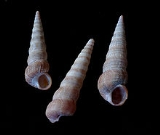
Turritella communis
Encyclopedia
Turritella communis is a species of medium-sized sea snail
s with an operculum
, marine
gastropod mollusks in the family Turritellidae
.
Isles south to the Mediterranean Sea
and North Africa. It is rare or absent from the eastern English Channel
and the southern North Sea
. This tower shell can be found in the sublittoral zone to depths up to 200 m, where it is usually found burrowed in gravelly mud at an angle of about 10°. There it remains stationary for long periods. It can be locally abundant on muddy sediment in shallow waters.
Fossil
and subfossil shells of Turritella communis have been found in interglacial
strata
in the North Sea, from the Late Pliocene to the Quaternary
Period.
is small. The outer lip is crenulate. There is no umbilicus. The concave operculum
is small and circular and has numerous pinnate bristles on its edges.
The snail shows white markings on the tentacles, siphon and foot. This small foot shows dark spots and streaks.
Snail
Snail is a common name applied to most of the members of the molluscan class Gastropoda that have coiled shells in the adult stage. When the word is used in its most general sense, it includes sea snails, land snails and freshwater snails. The word snail without any qualifier is however more often...
s with an operculum
Operculum (gastropod)
The operculum, meaning little lid, is a corneous or calcareous anatomical structure which exists in many groups of sea snails and freshwater snails, and also in a few groups of land snails...
, marine
Marine (ocean)
Marine is an umbrella term. As an adjective it is usually applicable to things relating to the sea or ocean, such as marine biology, marine ecology and marine geology...
gastropod mollusks in the family Turritellidae
Turritellidae
Turritellidae, the tower snails, is a taxonomic family of small to medium-sized sea snails, marine gastropod molluscs in the clade Sorbeoconcha.These snails are filter feeders...
.
Distribution and habitat
This species occurs from the LofotenLofoten
Lofoten is an archipelago and a traditional district in the county of Nordland, Norway. Though lying within the Arctic Circle, the archipelago experiences one of the world's largest elevated temperature anomalies relative to its high latitude.-Etymology:...
Isles south to the Mediterranean Sea
Mediterranean Sea
The Mediterranean Sea is a sea connected to the Atlantic Ocean surrounded by the Mediterranean region and almost completely enclosed by land: on the north by Anatolia and Europe, on the south by North Africa, and on the east by the Levant...
and North Africa. It is rare or absent from the eastern English Channel
English Channel
The English Channel , often referred to simply as the Channel, is an arm of the Atlantic Ocean that separates southern England from northern France, and joins the North Sea to the Atlantic. It is about long and varies in width from at its widest to in the Strait of Dover...
and the southern North Sea
North Sea
In the southwest, beyond the Straits of Dover, the North Sea becomes the English Channel connecting to the Atlantic Ocean. In the east, it connects to the Baltic Sea via the Skagerrak and Kattegat, narrow straits that separate Denmark from Norway and Sweden respectively...
. This tower shell can be found in the sublittoral zone to depths up to 200 m, where it is usually found burrowed in gravelly mud at an angle of about 10°. There it remains stationary for long periods. It can be locally abundant on muddy sediment in shallow waters.
Fossil
Fossil
Fossils are the preserved remains or traces of animals , plants, and other organisms from the remote past...
and subfossil shells of Turritella communis have been found in interglacial
Interglacial
An Interglacial period is a geological interval of warmer global average temperature lasting thousands of years that separates consecutive glacial periods within an ice age...
strata
Stratum
In geology and related fields, a stratum is a layer of sedimentary rock or soil with internally consistent characteristics that distinguish it from other layers...
in the North Sea, from the Late Pliocene to the Quaternary
Quaternary
The Quaternary Period is the most recent of the three periods of the Cenozoic Era in the geologic time scale of the ICS. It follows the Neogene Period, spanning 2.588 ± 0.005 million years ago to the present...
Period.
Description
The tall, conical shell is brownish-yellow to white. It is sharply pointed and contains 16-20 enlarged whorls. The spiral ridges are numerous (with 3 - 6 more prominent) and may have a beaded appearance. The shell grows to a length of 3 cm and may become 1 cm wide. The angulate shell apertureAperture (mollusc)
The aperture is an opening in certain kinds of mollusc shells: it is the main opening of the shell, where part of the body of the animal emerges for locomotion, feeding, etc....
is small. The outer lip is crenulate. There is no umbilicus. The concave operculum
Operculum (gastropod)
The operculum, meaning little lid, is a corneous or calcareous anatomical structure which exists in many groups of sea snails and freshwater snails, and also in a few groups of land snails...
is small and circular and has numerous pinnate bristles on its edges.
The snail shows white markings on the tentacles, siphon and foot. This small foot shows dark spots and streaks.
Feeding habits
Turritella communis feeds on deposits through ciliary feeding. In order to prevent larger particles entering the mantle cavity, it possesses at the mantle edge a curtain of tentacles of which the larger ones are pinnate.Further reading
- Kennedy, J. J. 1995. The courtship, pseudo-copulation behaviour and spermatophore of Turritella communis Risso 1826 (Prosobranchia: Turritellidae). Journal of Molluscan Studies 61:421–434.

